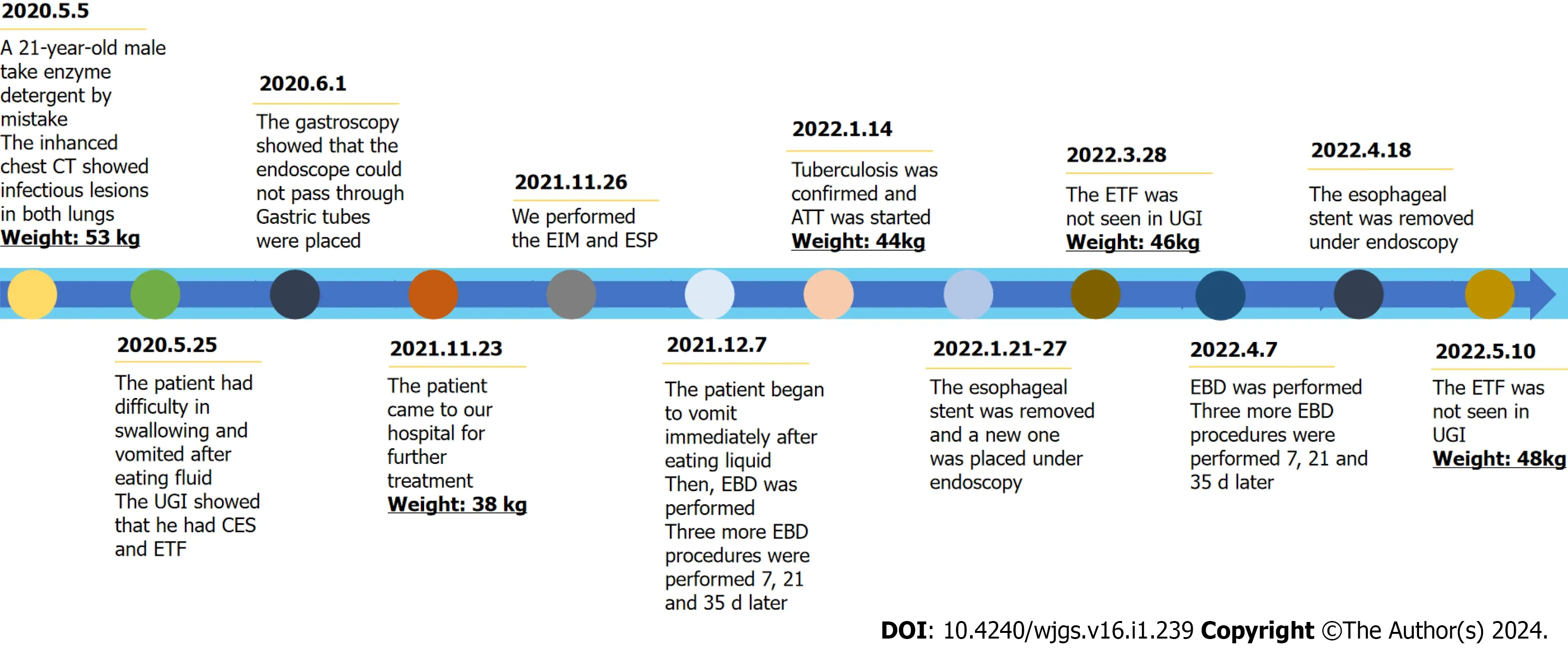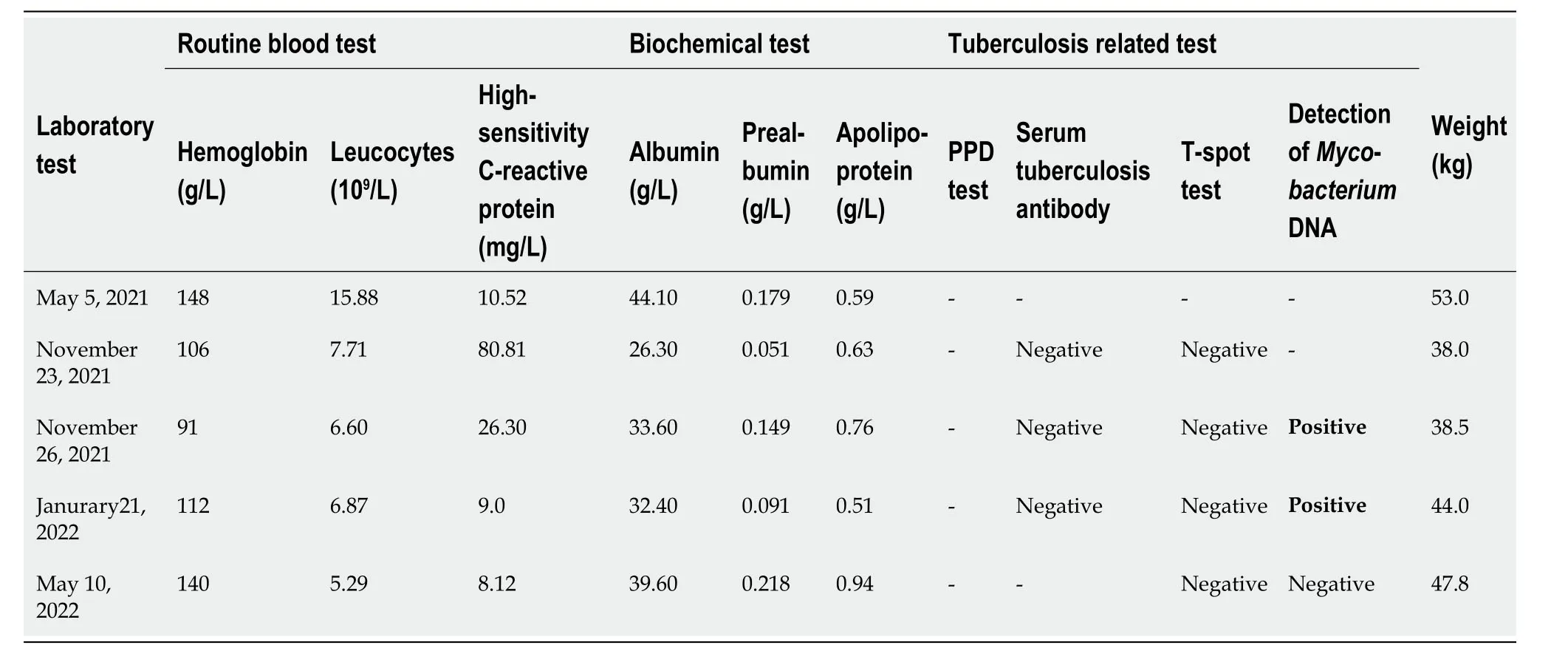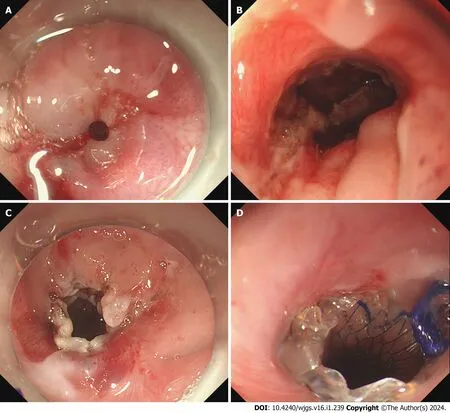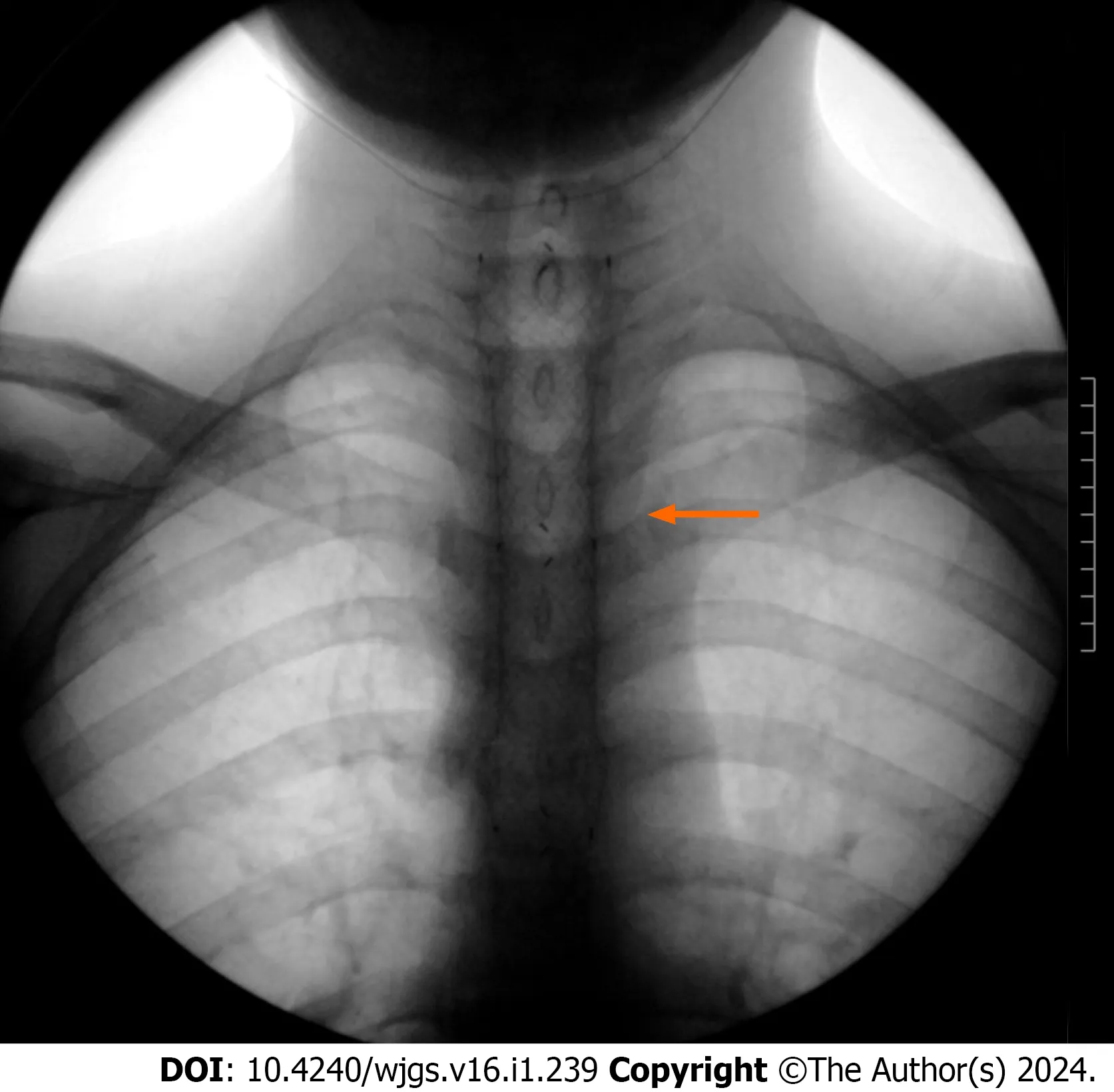Endoscopic treatment of extreme esophageal stenosis complicated with esophagotracheal fistula: A case report
2024-03-07JiaHengFangWeiMinLiChengHaiHeJianLiangWuYunGuoZhiChaoLaiGuoDongLi
Jia-Heng Fang,Wei-Min Li,Cheng-Hai He,Jian-Liang Wu,Yun Guo,Zhi-Chao Lai,Guo-Dong Li
Abstract BACKGROUND At present,there is no unified and effective treatment for extreme corrosive esophageal stenosis (CES) with esophagotracheal fistula (ETF).This case had extreme and severe esophageal stenosis (ES) and ETF after ingesting an enzymebased chemical detergent,resulting in a serious pulmonary infection and severe malnutrition.Upper gastrointestinal imaging showed that he had an ETF,and endoscopy showed that he had extreme and severe esophageal stricture.This case was complex and difficult to treat.According to the domestic and foreign literature,there is no universal treatment that is low-risk.CASE SUMMARY A patient came to our hospital with extreme ES,an ETF,and severe malnutrition complicated with pulmonary tuberculosis 1 mo after the consumption of an enzyme-based detergent.The ES was serious,and the endoscope was unable to pass through the esophagus.We treated him by endoscopic incision method (EIM),esophageal stent placement (ESP),and endoscopic balloon dilation (EBD) by using the bronchoscope and gastroscope.This treatment not only closed the ETF,but also expanded the esophagus,with minimal trauma,greatly reducing the pain of the patient.According to the literature,there are no similar reported cases.CONCLUSION We report,for the first time,a patient with extreme CES complicated with ETF,where the endoscope could not be passed through his esophagus but he could be examined by bronchoscopy and treated by EIM,ESP,and EBD.
Key Words: Extreme corrosive esophageal stenosis;Esophagotracheal fistula;Endoscopic incision method;Esophageal stent placement;Endoscopic balloon dilation;Case report
lNTRODUCTlON
Corrosive esophageal stenosis (CES) is rare but destructive,placing a significant burden on contemporary health systems around the world[1].Patients who have extreme CES with esophagotracheal fistula (ETF) often suffer from typical chest pain,severe pulmonary infection-related symptoms,malnutrition,etc.,which seriously affect the quality of their lives[2].Because of the rarity of this adverse event,clinicians usually have limited personal experience with it.Currently,there are no clinical evidence-based guidelines,and there is great uncertainty regarding the best treatment approach.
For the treatment of extreme CES with ETF,there is no relevant guidelines or a relatively unified treatment plan in clinical practice.At present,the main clinical treatments for esophageal stenosis (ES) are the endoscopic incision method (EIM),endoscopic balloon dilation (EBD),gastroscope-assisted bougienage,esophageal stent placement (ESP),and local injection of glucocorticoids[3].
Recently,a patient came to our hospital with extreme ES,an ETF,and severe malnutrition complicated with pulmonary tuberculosis 1 mo after the consumption of an enzyme-based detergent.The ES was serious,and the endoscope was unable to pass through the esophagus.We treated him by EIM,ESP,and EBD using the bronchoscope and gastroscope.This treatment not only closed the ETF,but also expanded the esophagus.All treatment events are displayed on the timeline in Figure 1.It solved the problem with minimal trauma and greatly reduced the pain of the patient.According to the literature,there are no similar reported cases.

Figure 1 Treatment timeline. ATT: Antituberculosis therapy;CT: Computed tomography;CES: Corrosive esophageal stenosis;EBD: Endoscopic balloon dilation;EIM: Endoscopic incision method;ESP: Esophageal stent placement;ETF: Esophagotracheal fistula;UGI: Upper gastrointestinal imaging.
CASE PRESENTATlON
Chief complaints
A 21-year-old man came to the Department of Gastroenterology of our hospital for "having upper gastrointestinal pain with dysphagia after mistakenly consuming an enzyme-based detergent 6 mo ago".The patient developed burning sensation and pain in the the oral,throat,and chest behind the sternum and under the xiphoid process after taking an enzyme-based detergent by mistake on May 5,2020.The pain score was 8 (total score: 10).Contrast enhanced chest computed tomography (CT) showed infectious lesions in both lungs.Anti-infection treatment was given and the patient was discharged after improvement.On May 25,2020,the patient had difficulty in swallowing and vomited after eating fluid food.Upper gastrointestinal imaging (UGI) showed that he had CES and pharyngeal fistula (Figure 2),but the patient decided to return to the local hospital for treatment.Gastroscopy was performed in the First Hospital of Lanzhou University on June 1,2020,which showed that the esophagus was narrow 19 cm away from the incisors,and the endoscope could not pass through.Esophageal scar hyperplasia was noticeable,and it was brittle and prone to bleeding.A gastric tube was placed for enteral nutrition.At 6 mo,the patient's weight had decreased by 15 kg.Finally,the patient came to our hospital for further treatment (November 23,2021).On admission,continuous enteral nutrition was given since the patient complained of dysphagia and vomiting immediately after eating.He had persistent pain behind the sternum and under the xiphoid process.The pain score was 4 (total score: 10).The patient had shortness of breath,accompanied by cough and expectoration.The sputum was yellow and purulent,which was semisolid and difficult to expectorate.

Figure 2 Upper gastrointestinal imaging showed corrosive esophageal stenosis and pharyngeal fistula. A: Upper gastrointestinal imaging (UGI) indicated that the patient had a pharyngeal fistula (yellow arrow);B: UGI indicated that the patient had total esophageal stenosis.
History of present illness
The patient mistakenly consumed an enzyme-based detergent 6 mo ago.
History of past illness
The patient was healthy in the past.
Personal and family history
There was no remarkable personal and family history.
Physical examination
The Kubota water swallow test suggested that the patient had grade 5 swallowing function.The trachea was in midline,the breathing sounds in both lungs were not clear,and moist rales could be heard in the left lung.Bowel sounds at a frequency of 3-5 times/min could be heard.
Laboratory examinations
The results are all shown in Table 1.

Table 1 The patient’s laboratory test results and weight
Imaging examinations
The UGI and endoscopy results are shown in the figures.
FlNAL DlAGNOSlS
Extreme ES complicated with an ETF.
TREATMENT
The patient was treated with nutritional support therapy and anti-infection therapy.The test results are shown in Table 1.Contrast-enhanced chest CT showed that the patient had ES.Hypopharyngeal and esophageal injury and partial gas accumulation can be seen.There were pneumonic lesions in both lungs.UGI (Figure 3) showed that the pharyngeal fistula disappeared,the esophageal mucosa was rough and disordered,the esophageal wall was irregular,an ETF appeared,and the fistula was located at the level of the 4ththoracic vertebra.After determining the location of the ETF,relevant surgical contraindications were excluded.On November 26,2021,bronchoscopy (Olympus BF-260) instead of gastroscopy was used to evaluate the esophagus,which showed that the whole esophagus was narrow and twisted,and three fistulas were found in the upper part of the esophagus (Figure 4A and B).The obvious stenosis part was located 19 cm and 38 cm away from the incisors.The patient’s following conditions posed great challenges to the treatment: (1) The patient had total ES combined with ETF.Gastroscope could not be use to assess the condition and treat him;and (2) The length of ES in the patient is much longer than that of the existing stent.

Figure 3 Upper gastrointestinal imaging at admission.A: Upper gastrointestinal imaging (UGI) indicated that the patient had an esophagotracheal fistula (yellow arrow);B: UGI indicated that the patient had total esophageal stenosis.

Figure 4 The endoscopic incision method and esophageal stent placement performed at admission.A: The esophageal stenosis part which made the endoscope unable to enter;B: There were fistulas in the patient's esophagus;C: The esophageal lumen increased significantly after treatment by the endoscopic incision method;D: The upper end of the stent after placement.
We performed EIM with a gastroscope (Olympus GIF-H290Z) at 19 cm (Figure 4C).The bronchoscope was used again to enter the gastric cavity and to insert the guidewire (AG-5043-3545,Hangzhou Honghai Medical Devices Co.,Ltd.).After the bronchoscope was withdrawn,the gastroscope was placed to send the esophageal stent pusher (NES-20-120-070,Hangzhou Qianshenghui Science and Technology Ltd.) along the guidewire.Then,we released the covered stent under direct vision of the endoscope.It was found that the release position was good,the upper end was located 17 cm away from the incisors (Figure 4D),the inside of the stent was clear,and there was no obvious bleeding.On the second day after the operation,the patient had minor pharyngeal pain,with no obvious retrosternal pain and no pain under the xiphoid process.He drank fluids and had no discomfort after eating.Esophageal radiography (Figure 5) showed that the esophageal dilation was good,no contrast medium overflow was found,and the cardia opened and contracted regularly and freely.On December 7,2021,the patient began to vomit immediately after eating liquid food.The vomitus was food.The rating grade of the Kubota water swallow test was 5.Then,EBD was performed with an endoscope (No.: ES128549).The stent was still in place.A narrow esophageal lumen could be seen 38 cm away from the incisors,and the endoscope could not pass through.A guidewire was placed through the narrow part,and a columnar dilatation balloon of the duodenal papilla (BDC-12/55-7/18,Hangzhou Weichuang Medical (Group) Co.,Ltd.) was placed along the guidewire.After dilation,the mucosa was torn,and the gastroscope could enter the gastric cavity through the narrow segment.Three more EBD procedures were performed 7,21,and 35 d later (BDC-12/55-7/18,BDC-15/55-7/18,and BDC-15/55-7/18,Hangzhou Weichuang Medical (Group) Co.,Ltd.).The patient could drink fluids or semi-fluids during this period.

Figure 5 After esophageal stent placement,the stent was in place and esophageal dilation was good.
During hospitalization,the patient still suffered from cough and expectoration and maintained a low fever every day.Although the laboratory examination results did not support the diagnosis of pulmonary tuberculosis,we used bronchoscopy to collect bronchial lavage fluid to performMycobacterium tuberculosisculture.Tuberculosis was confirmed (Table 1) and four-drug antituberculosis therapy (ATT) was started.Finally,the patient's persistent pain behind the sternum and under the xiphoid process,pharyngeal pain,and other discomfort disappeared,the nutritional index increased continuously,and his weight increased by 7 kg.The patient could tolerate the exercise of normal activities,and the quality of his life was greatly improved.
OUTCOME AND FOLLOW-UP
To avoid the implantation of the stent into the esophageal mucosa,we decided to remove the esophageal stent and place a new one.We removed the stent on January 1,2022.Seven days later,a new stent was placed.The two operations went well,upper esophageal mucosal erosion was found,the esophageal cavity dilated well,and the fistulas disappeared.ES could be seen 36 cm away from the incisors.The patient kept having semi-fluids.Sustained nutritional support and ATT were given.Since UGI showed that the fistula had been blocked,we removed the stent on April 18,2022 (Figure 6) and four times of EBD was performed since April 7,2022 to dilate the esophagus.A month later,UGI showed that the fistula was still blocked (Figure 7),but the esophagus was still partially narrow.The patient could have semi-fluids at that time.ETF may recur,and the patient may have to accept EIM,ESP,and EBD in the future.

Figure 6 The stent was removed finally. A: The stent was in place;B: The stent was being removed;C: After the stent was removed,the esophageal cavity expanded significantly;D: The removed stent.

Figure 7 The fistula was blocked,but the esophagus was partially narrow. A: There was no esophagotracheal fistula;B: The esophagus was partially narrow.
DlSCUSSlON
Since the physiological structure of the esophagus is thin and tubular,it is prone to stenosis when subjected to major injuries,such as corrosion and surgery.The incidence of esophageal stenosis is approximately 1.1/100000 cases per year[4].Chronic ETF is extremely rare and occurs in approximately 3% of patients with chemically CES[1].The treatment mainly includes the repair of airway defects and esophageal reconstruction,which usually uses staged operation[5,6].The first stage,as most clinicians think,is endoscopic esophageal dilatation (including EBD and bougienage)[7].This case is very special for the following reasons: First,the patient was very young.If we chose surgical resection of the whole esophagus,the quality of life would be greatly reduced in the coming decades.Second,endoscopy suggested that the patient’s esophagus was entirely narrow with multiple fistulas.The guidewire was very likely to be displaced during the EBD.Even if the dilation were successful,the large balloon pressure could easily tear the fistula mucosa and cause further damage.Considering comprehensively,we immediately performed EIM,which made it possible to expand the esophageal cavity and provide further ESP.As a new technology,EIM shows amazing feasibility and effectiveness.
There is no unified clinical treatment for complex CES.EIM is a new technology developed in recent years that was first used to treat recurrent Schatzki rings.Since 2012,it has gradually replaced EBD to be used to treat complex esophageal anastomotic stenosis[8].Wuet al[9] have shown that EIM for complex ES is safe and can significantly alleviate the clinical symptoms of dysphagia in a short time,but its long-term effect is still uncertain.Liet al[10] and Hordijket al[11] believed that EIM benefits patients who have severe and complex benign ES and have fewer side effects.In this case,the total esophageal tube was narrow,there were multiple fistulas in the esophagus,and it was difficult to reach the gastric cavity with the guidewire.We performed EIM for upper ES,which expanded the esophageal cavity and created the possibility of subsequent treatments.
As one of the treatments for ES,ESP has many adverse events,such as chest pain,stent displacement or shedding,and tissue embedding.Fuccioet al[12] performed a meta-analysis indicating that approximately 28.6% of patients had esophageal stent displacement and 20.6% had adverse events.Therefore,ESP is not recommended as the best treatment for benign ES[3].For cases of malignant ES complicated with ETF,ESP is the recommended scheme[3].For the treatment of benign ES combined with ETF,there has been no recommended treatment.The patient faced the following two problems on admission: (1) The patient’s esophagus was completely narrow,and the endoscope was unable to pass through;and (2) The patient had stenosis complicated with an ETF.Therefore,we believed that the most appropriate treatment was EIM and ESP.On the one hand,the covered stent can block the ETF and promote self-healing;on the other hand,the covered stent can dilate the narrow esophagus and alleviate the symptoms of dysphagia.There were no adverse events,such as stent displacement or stent insertion.The esophagus was unobstructed after placement,and the fistula was closed after stent removal.It was proven to be a reasonable treatment for benign ES complicated with ETF.
Patients with extreme CES often have to accept EBD dozens of times.They go through a great deal,and the esophagus is easy to tear after operation.The medical cost is also high.The expansion success rate for corrosive stenosis is approximately 50%,which is significantly lower than that for other benign stenoses (75%-80%)[7].For the stenosis part located below the esophageal stent in this case,considering the tear caused by ordinary balloon dilatation,we used the duodenal papilla columnar expansion balloon to expand the esophagus by dividing segments.We performed this three additional times at 7,21,and 35 d after the initial EBD.The inner diameter of the balloon increased in turn during each expansion.The patient maintained a liquid and semiliquid diet during this period,without obvious tearing,perforation,bleeding,or other adverse events.For the treatment of lower ES,there are two choices: ESP or ESP after EBD.More clinical studies are needed to prove which one has better safety,efficacy,and economic benefits.
For the treatment of benign ES,Xieet al[13] believed that oral administration of glucocorticoids in patients with diabetes,hypertension,infection,tuberculosis,and other patients will lead to aggravation,so it is not recommended.The effect of glucocorticoid injection is ideal,but no drug injection has been proven to be effective for the treatment of chemically CES,and corticosteroids also have no benefits[14].Enzyme-based chemical detergent could corrode the patient’s esophagus,and long-standing tuberculosis infection for more than 2 mo also could lead to an acquired ETF.We believe that ATT is also crucial for the healing of ETF and subsequent recovery,so we used ATT immediately as soon as tuberculosis was confirmed.Khanet al[15] cured a patient who had tuberculous fistulas successfully with ATT,which supports our view.
CONCLUSlON
Chemical corrosive esophageal injury should be examined by gastroscopy combined with UGI,nasal endoscopy,and even bronchoscopy when necessary.For treatment,EIM,EBD,and ESP should be chosen according to every patient’s specific situation.Due to entire CES combined with ETF having a wide range of stenosis,the treatment is extremely difficult.Clinical treatment should be taken under individualized assessment,and combined treatment should be given when necessary.In this case,we used a bronchoscope with a thinner diameter to evaluate and treat ES repeatedly instead of a gastroscope,which was rarely used in clinical practice and achieved a perfect effect.Whether the ETF and ES will recur in this patient remains to be observed.
FOOTNOTES
Author contributions:Li GD performed all surgical treatments;Fang JH prepared the initial draft of the manuscript and revised the manuscript;Li GD and Wu JL critically reviewed and revised the manuscript and provided input on the endoscopic operation aspects of the manuscript;Guo Y,Lai ZC,Li WM,and He CH contributed equally toward the senior authorship of this manuscript;all authors contributed to the article and approved the submitted version.
lnformed consent statement:The study was reviewed and approved by Hangzhou Normal University Affiliated Hospital’s ethics committee.The patient provided written informed consent for the publication of this case report.
Conflict-of-interest statement:There is no conflict of interest to disclose.
CARE Checklist (2016) statement:The authors have read the CARE Checklist (2016),and the manuscript was prepared and revised according to the CARE Checklist (2016).
Open-Access:This article is an open-access article that was selected by an in-house editor and fully peer-reviewed by external reviewers.It is distributed in accordance with the Creative Commons Attribution NonCommercial (CC BY-NC 4.0) license,which permits others to distribute,remix,adapt,build upon this work non-commercially,and license their derivative works on different terms,provided the original work is properly cited and the use is non-commercial.See: https://creativecommons.org/Licenses/by-nc/4.0/
Country/Territory of origin:China
ORClD number:Jia-Heng Fang 0000-0002-3496-1438;Cheng-Hai He 0000-0001-8322-2669;Guo-Dong Li 0000-0002-8389-4075.
S-Editor:Lin C
L-Editor:Wang TQ
P-Editor:Xu ZH
杂志排行
World Journal of Gastrointestinal Surgery的其它文章
- Prospects in the application of ultrasensitive chromosomal aneuploidy detection in precancerous lesions of gastric cancer
- Prognostic value of ultrasound in early arterial complications post liver transplant
- Added value of ratio of cross diameters of the appendix in ultrasound diagnosis of acute appendicitis
- Single-incision laparoscopic transabdominal preperitoneal repair in the treatment of adult female patients with inguinal hernia
- Predictive value of machine learning models for lymph node metastasis in gastric cancer: A two-center study
- Micro-power negative pressure wound technique reduces risk of incision infection following loop ileostomy closure
